Prevent Shopify Cart and Checkout Abandonment: 20 Tested Ideas



Anyone running an online store knows the sting of Shopify cart abandonment, when promising shoppers add products to their carts only to abandon them before completing the purchase.
With the average cart abandonment rate hovering around 70.22%, reducing cart abandonment on Shopify has become a top priority for every growth-focused brand.
But it doesn’t stop there.
Shopify checkout abandonment is another challenge, where customers start entering shipping and payment details, then abandon the checkout before finishing.
Both cart and checkout abandonment tend to spike during the holiday season, when choice overload, festive distractions, and last-minute decisions rule.
In fact, December consistently records the highest cart abandonment rates across eCommerce.
To help you tackle this, we’ve rounded up tested strategies and Shopify apps that can help you reduce abandoned carts and recover lost sales, boosting conversions and keeping your customers engaged till checkout.
The sections covered in this piece are:

Not every shopper who abandons their cart is lost; some just need more time or reassurance before committing.
One powerful way to prevent Shopify cart abandonment is by adding a lightweight “Save for Later” micro-survey when a user shows exit intent or spends too long in the cart.
This one-click prompt might ask:
“Still thinking? Want us to hold this for 24 hours?”
“Need more time? Save your cart and pick up where you left off.”
This simple interaction achieves two crucial things:
With Shopify apps like Tidio, ReConvert, or Fairing, you can integrate micro-surveys seamlessly into the cart or checkout flow.
You can even automate it using Shopify Flow if you’re on Shopify Plus, so that saved carts trigger personalized reminders later.
Compared to traditional abandoned cart emails, which many users ignore or turn off, this approach prevents the abandonment from happening in the first place.
It also gives shoppers a sense of control, turning hesitation into a “not yet” instead of a “no.”

Many shoppers abandon their carts not because they lose interest but because they hesitate, unsure if the price or offer will change later.
Instead of pressuring them with countdown timers (which can feel manipulative), you can use soft time-bound cart locks to reassure customers that their deal is safe.
For example, when someone adds an item to the cart, show a small reassurance banner like:
“We’ve locked your price for the next 30 minutes.”
“This item and offer are reserved for you until [time].”
This simple cue creates psychological comfort, and it reduces “price-change anxiety,” a major cause of Shopify cart abandonment.
Customers feel more in control, knowing they won’t lose the current offer if they take a few minutes to decide.
If you’re on Shopify Plus, you can automate this with Shopify Scripts or Shopify Flow, dynamically locking product prices or displaying real-time countdowns for high-intent carts.
For other plans, Shopify apps like Ultimate Special Offers, Cart Reserved, or Sales Countdown Timer Bar 2.0 help implement similar “soft locks” without adding hard-sell pressure.
This approach is far more effective than sending another Shopify abandoned cart email after they’ve already left, because it prevents abandonment in real time.
Instead of chasing customers later, you give them confidence now.
Sometimes shoppers abandon their carts not because they don’t want the product, but because they’re uncertain if it’s the right choice.
That’s where predictive cart nudges come in, subtle in-cart messages triggered by browsing behavior that reassure customers at the moment of decision.
For example, if a user hovers over a product multiple times or revisits it before adding to the cart, you can show contextual messages like:
“Over 900 people bought this combo last month.”
“Most buyers paired this with [accessory/product].”
These small social proof cues build confidence and validation, reducing hesitation and lowering shopping cart abandonment rates.
By providing real-time reassurance, you’re addressing buyer uncertainty before it turns into an abandoned checkout Shopify scenario.
U.S.-based Shopify store owners can implement predictive nudges using apps like ReConvert, Fera.ai, or LimeSpot, which integrate seamlessly with your store and allow automated, behavior-based messaging.
For Shopify Plus merchants, Shopify Scripts and Flow can further personalize nudges based on past order history or cart value, making each message feel targeted rather than generic.
Compared to chasing users with follow-up emails, which many ignore or opt out of (how to turn off Shopify abandoned cart email), predictive nudges prevent cart abandonment in real time.
They are a proactive approach to reducing abandoned carts with a Shopify app and increasing checkout completion.
Not all cart abandonment comes from disinterest; often, shoppers simply hesitate or feel unsure.
One advanced way to tackle Shopify cart abandonment is by monitoring mini-cart behavior in real time.
If a shopper repeatedly opens and closes the mini-cart without proceeding to checkout, it’s a clear signal of indecision rather than a lack of interest.
At this moment, you can deploy hyper-personalized exit popups or in-cart nudges, such as:
“Still deciding? Most customers paired this item with [related product].”
“Need more info? Here’s why buyers loved this combo.”
This way of targeting indecision rather than disinterest, you can subtly guide shoppers toward completing their purchase without pressuring them.
The key is timing, triggering messages as the hesitation occurs is far more effective than sending a post-abandonment email, which many users ignore or unsubscribe from (how to turn off Shopify abandoned cart email).
For U.S.-based Shopify stores, apps like LimeSpot, Fera.ai, or Privy can track mini-cart interactions and deliver personalized, real-time nudges.
Shopify Plus merchants can also leverage Shopify Scripts and Flow to automate behavioral triggers and messaging directly in the mini-cart or checkout drawer.
This strategy not only reduces abandoned carts with a Shopify app but also transforms passive browsing into active engagement, addressing the root cause of Shopify abandoned checkout scenarios.
One of the most powerful ways to prevent Shopify cart abandonment is to engage customers before they hesitate.
Shopify Magic, the platform’s AI-driven personalization tool, allows store owners to dynamically customize in-cart messages based on a shopper’s location, behavior, and browsing history.
For instance, if a customer from New York adds items to their cart, Shopify Magic can trigger a personalized note like:
“Looks like you’re shopping from New York, free delivery applies today!”
“Your favorite combo is almost out of stock. Grab it now!”
These predictive, context-aware messages help customers feel seen and reassured, reducing uncertainty and indecision, common triggers for Shopify abandoned checkout.
When you provide relevant, real-time information, you can make the checkout experience feel intuitive and trustworthy, increasing the likelihood of completing the purchase.
For U.S.-based Shopify store owners, Shopify Magic can be combined with Shopify Flow or apps like ReConvert and Fera.ai to automate behavior-based messaging across carts and checkouts.
Unlike traditional Shopify abandoned cart emails, which only react after a customer has left, predictive messaging works proactively, preventing abandonment before it happens.
A common reason for Shopify cart abandonment is friction when shoppers switch devices.
A customer might start adding items on their mobile phone during lunch but later switch to a desktop at home, only to find their cart empty or incomplete.
This often leads to abandoned checkout Shopify scenarios.
Shopify automatically saves cart sessions for logged-in users, but apps like ReCart and PushOwl extend this capability to guest shoppers and across multiple devices and browsers. Shoppers can:
This seamless cart experience prevents unnecessary interruptions, keeping the checkout flow smooth and increasing the likelihood of completing purchases.
Unlike traditional Shopify abandoned cart emails, which attempt to recover sales after customers leave, smart cart persistence ensures carts remain intact before abandonment occurs.
This helps U.S.-based Shopify store owners reduce Shopify shopping cart abandonment and improve overall conversion rates, especially during busy shopping periods or holidays.
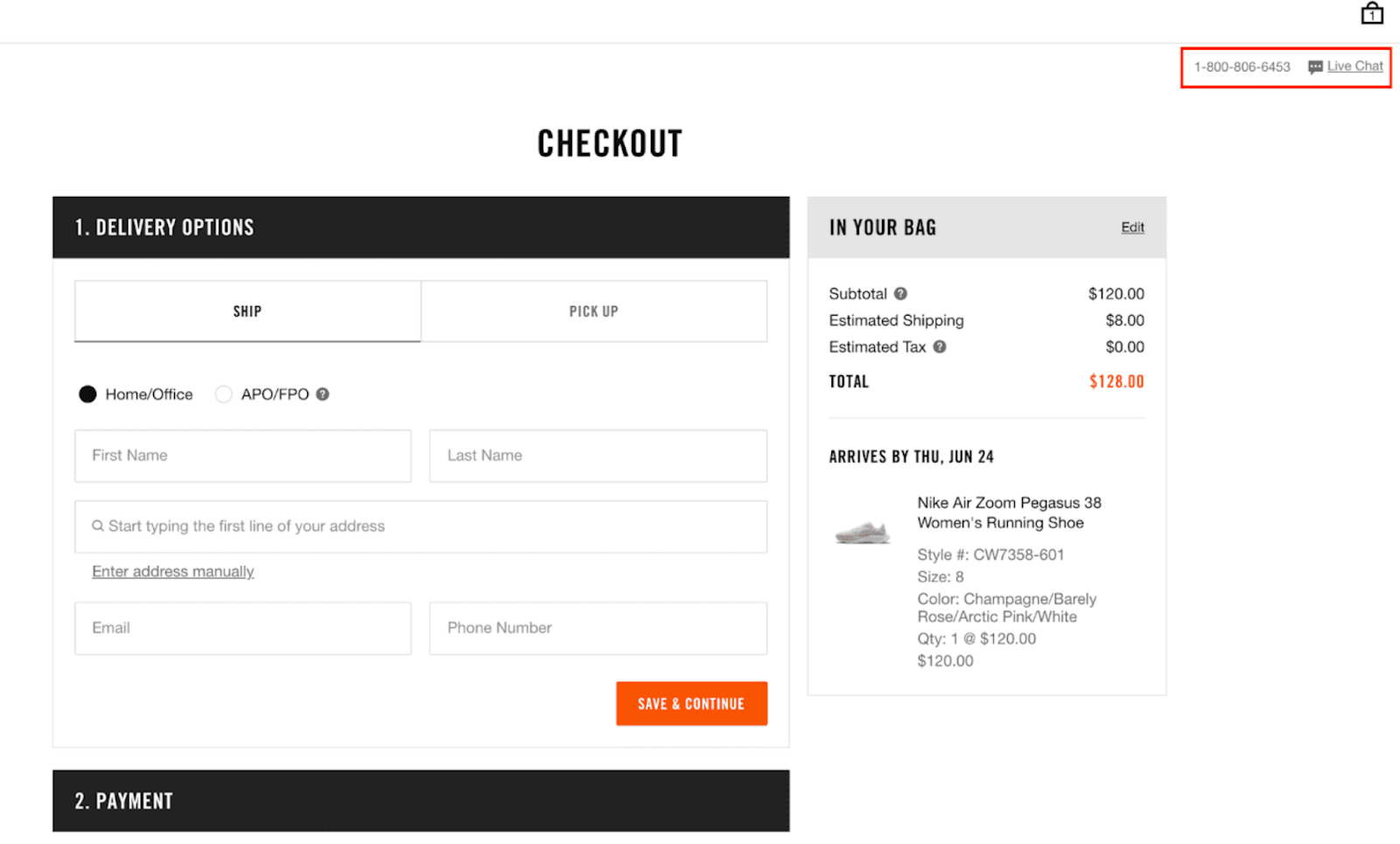
Shoppers often abandon carts due to uncertainty, and questions about delivery, sizing, or product compatibility can make them pause or leave to search for answers elsewhere.
Offering live chat or WhatsApp support directly within the cart drawer helps intercept these concerns at the critical moment, reducing Shopify cart abandonment.
For example, a small, context-aware prompt can appear while a customer is reviewing their cart:
“Need help with delivery time or sizing? Chat with us now.”
“Have a question about this item? Message us on WhatsApp and get instant support.”
Shopify store owners can use apps like Tidio, Gorgias, or WhatsApp for Shopify to integrate real-time messaging into the cart or checkout flow.
These tools allow support teams to answer questions instantly, helping customers feel confident and reducing hesitation that leads to abandoned checkout on Shopify.
This approach addresses concerns before they turn into abandoned cart Shopify scenarios.
Unlike traditional follow-up methods, such as Shopify abandoned cart emails, which only react after the customer leaves, live cart support works proactively, providing reassurance, answering questions in real time, and smoothing the path to purchase.
Many shoppers abandon carts not because of price or product concerns, but due to decision fatigue or distraction.
Emotional momentum messages help maintain engagement throughout the checkout process, encouraging shoppers to complete their purchase instead of leaving mid-flow.
Examples of these subtle cues include:
“Almost done! Just one step away from your order.”
“This product’s waiting for you, don’t miss out!”
These micro-affirmations create a sense of continuity and reassurance, helping customers feel guided and supported as they progress through checkout.
Shopify store owners can implement them using apps like ReConvert, Fera.ai, or Zipify OneClickUpsell, or integrate messages directly into the cart and checkout via Shopify Scripts and Flow on Shopify Plus.
When done thoughtfully, this strategy lowers Shopify shopping cart abandonment rates and also enhances the overall customer experience, keeping buyers engaged and more likely to complete their purchase.

Even with proactive measures, some shoppers may still leave before completing checkout.
A well-planned abandoned cart recovery strategy can help recapture these potential sales and reduce the impact of Shopify cart abandonment.
Shopify store owners can implement multiple tactics:
A structured recovery strategy also allows store owners to track abandoned checkout Shopify trends, understand common drop-off points, and fine-tune messaging to prevent repeat abandonments.
Pro Tip:
Engage is an out-and-out email marketing platform that can help your Shopify business reel back customers who have abandoned their cart. Alongside, this tool also ensures you make the most of your email marketing strategy around wishlist reminders, welcome communication, and upsells & cross-sells.
The cart summary is more than just a recap of prices and fees; it’s a critical point to prevent Shopify cart abandonment.
Shoppers often hesitate at this stage, double-checking costs or reconsidering their purchase. Highlighting a clear, tangible benefit in the cart can motivate them to complete checkout immediately rather than postponing.
This benefit could be a free gift, loyalty points, or a limited-time bonus.
For example, the well-known Shopify brand Luxy Hair not only offers a free gift automatically but also lets customers select an additional free gift.
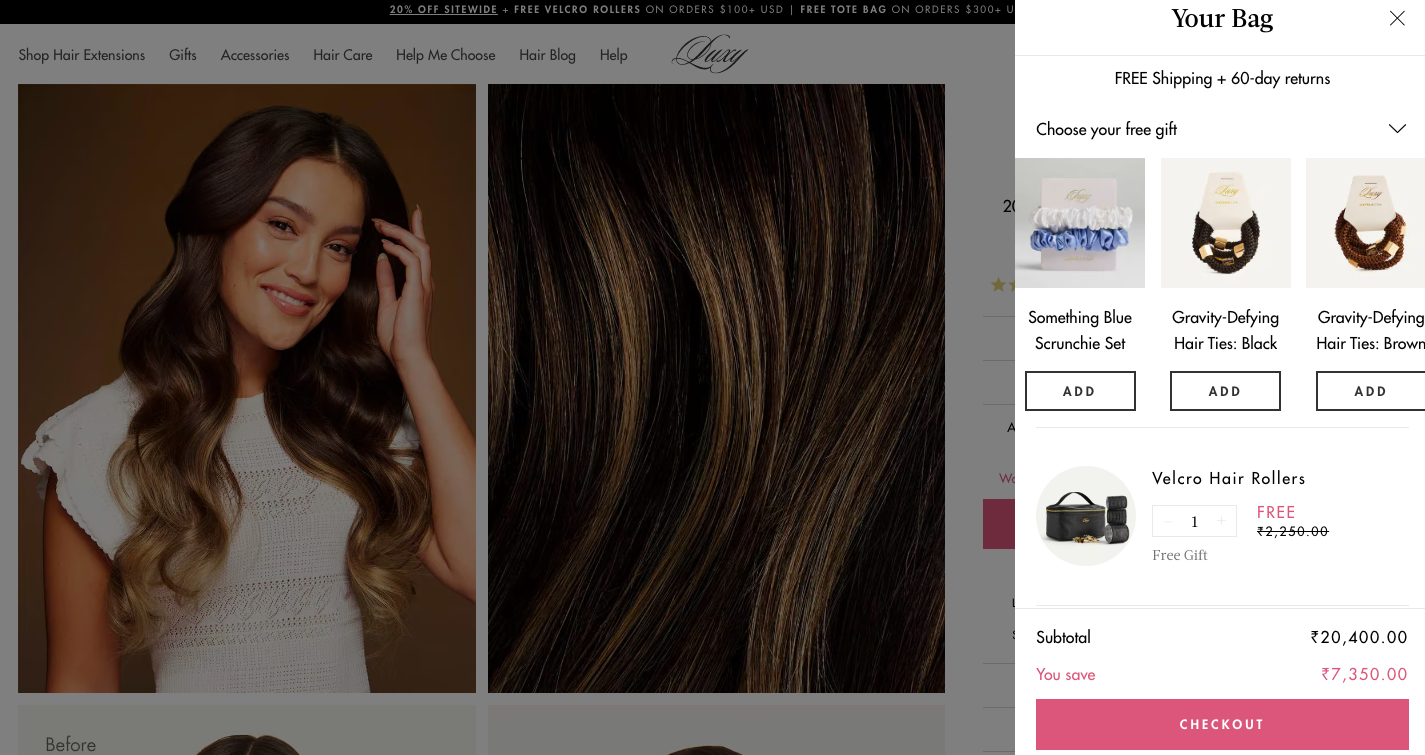
This approach creates a sense of immediate reward and enhances the perceived value of the purchase, making the checkout decision feel urgent and worthwhile.
Shopify store owners can implement similar strategies using apps like Bold Upsell, ReConvert, or Ultimate Special Offers, which allow you to feature clear benefits dynamically in the cart or checkout summary.
Adding this type of visual or textual reinforcement addresses hesitation and can directly reduce abandoned cart Shopify rates.
Security is one of the top concerns for online shoppers in the U.S., and uncertainty about payment safety can quickly lead to Shopify cart abandonment.
Fortunately, Shopify ensures that all its stores are PCI compliant, covering six essential categories:
On top of this, installing an SSL certificate for your store ensures that every transaction is encrypted.
Displaying the SSL badge prominently reassures shoppers that their sensitive information, like payment details and personal data, is protected.
Additionally, TLS (Transport Layer Security) certificates provide an extra layer of protection for both merchants and customers.
If your store has TLS activated, make it visible to shoppers, either through badges, pop-ups, or a simple “Secure Checkout” message in the cart and checkout areas.
For U.S.-based Shopify store owners, highlighting security credentials can reduce hesitation at the final purchase step, decreasing checkout abandonment.
Customers who feel confident in the security of your store are far more likely to complete purchases, lowering overall Shopify cart abandonment rates.
Even small visual cues, a “Secure Checkout” icon, an SSL badge, or a trust seal, can act as a psychological nudge, turning potential abandoned cart Shopify scenarios into completed sales.
Combining this with other proactive strategies, like cart persistence across devices or emotional momentum messages, strengthens trust and ensures a smoother checkout experience.
Lengthy or complicated checkout processes are one of the main reasons for Shopify cart abandonment.
Many shoppers abandon carts simply because creating an account feels like extra work or navigating multiple checkout pages becomes tedious.
Combining guest checkout with a one-page checkout format streamlines the process even further.
A single-page checkout allows customers to enter shipping, billing, and payment information without jumping through multiple screens, reducing hesitation and Shopify abandoned checkout incidents.
For example, Jeffree Star Cosmetics, a Shopify brand, provides a clean, one-page guest checkout experience.

This setup lets customers complete purchases quickly, minimizing friction and lowering shopping cart abandonment on Shopify.
Shopify store owners can implement this using Shopify’s native checkout settings or apps like Shopify Plus custom checkout scripts, Fast Checkout In One Click, or One-Page Checkout by Zipify.
Offering a guest-friendly, streamlined checkout significantly improves conversion rates and helps prevent abandonment before it occurs.
Shoppers often abandon carts when their preferred payment option isn’t available.
Offering multiple payment choices reduces Shopify cart abandonment by giving customers the flexibility to complete their purchase in the way that’s most convenient for them.
Alongside standard credit and debit cards, consider adding:
For example, Thrive Causemetics offers a variety of globally recognized digital payment options, making checkout faster and more reassuring for customers.
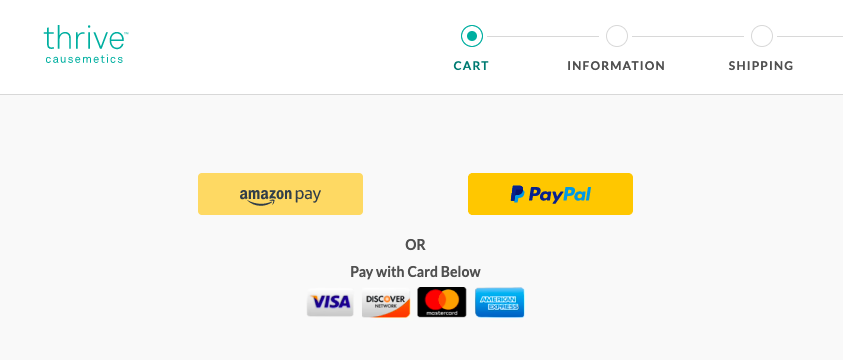
Offering flexible payment options also includes split payments or shared payments, which are especially useful for gifts or larger purchases.
Shopify-specific apps can help implement these features effectively:
The timing of your abandoned cart emails is just as important as the message itself.
Sending reminders too early can feel pushy, while sending them too late may miss the window when shoppers are still interested.
Optimizing Shopify abandoned cart emails can significantly reduce Shopify shopping cart abandonment and recover potentially lost sales.
Here’s an effective staggered approach for U.S.-based Shopify store owners:
First Reminder (4–6 hours after abandonment)
Focus on the items left behind and provide subtle social proof, like:
“These items are popular with other shoppers this week!”
This gentle nudge reminds customers what they were considering without feeling intrusive.
Second Reminder (within 1–2 days)
At this stage, consider adding incentives, such as a discount, free shipping, or a personalized free gift. Highlighting added value makes the purchase more compelling and increases the likelihood of recovery.
Third Reminder (within a week)
This final reminder should create urgency with clear calls to action. Including customer reviews or testimonials can reassure hesitant buyers that your products are trusted and worth completing the purchase.
For example, Casper, a leading mattress brand on Shopify, sends abandoned cart emails featuring customer reviews, which help reinforce trust while nudging buyers toward completing their purchase.

Shipping options play a major role in Shopify cart abandonment.
Customers are more likely to abandon their cart if the available shipping options feel limited, unclear, or unexpectedly expensive.
Offering multiple shipping types and charging for them separately gives shoppers the flexibility they need while keeping your margins intact.
Shopify’s Carrier Calculated Shipping (CCS) method allows U.S.-based merchants to provide real-time shipping rates from major carriers such as UPS, FedEx, and USPS.
You can display multiple options during checkout, for example:
For merchants using third-party carriers, Shopify also supports integration via your admin panel, allowing custom shipping rates and options to appear seamlessly at checkout.
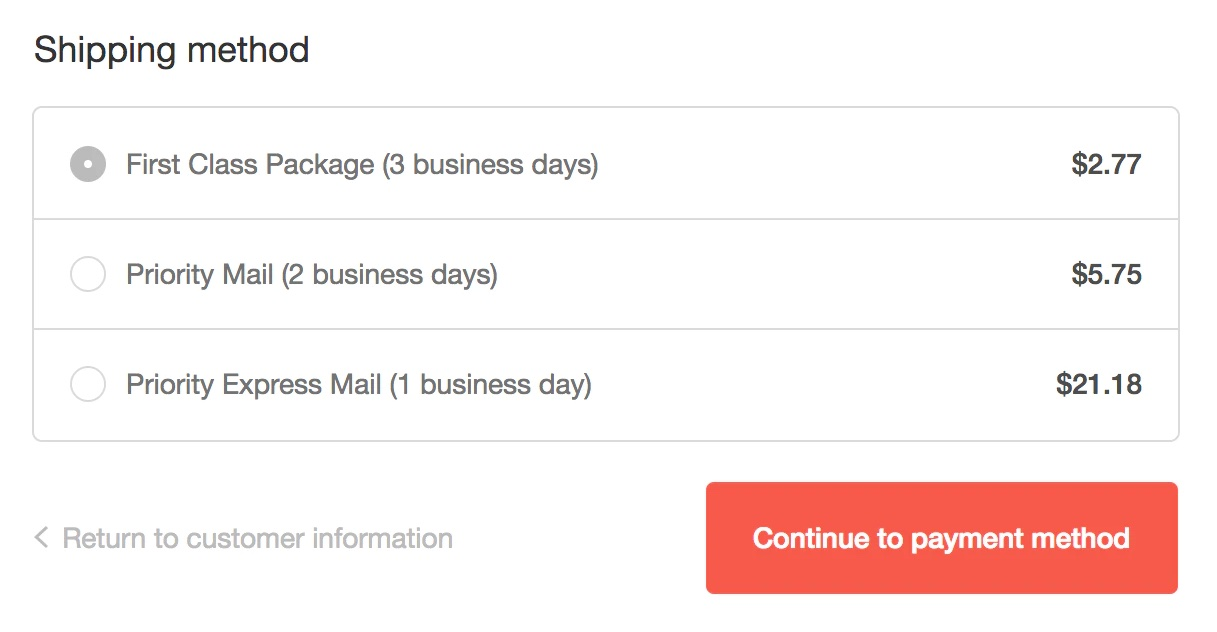
Clearly presenting shipping choices helps reduce friction and prevent abandoned checkout situations on Shopify stores.
Customers feel in control of delivery speed and cost, which minimizes surprises and builds trust.
Even when a customer has added products to their cart, uncertainty about final costs can trigger Shopify cart abandonment.
Many shoppers abandon checkout when shipping, taxes, or additional fees appear unexpectedly.
Providing a clear and organized price breakdown ensures transparency, builds trust, and reduces hesitation at the last stage of the purchase.
A neat price breakdown typically includes:
For example, Death Wish Coffee, a Shopify store, clearly shows shipping rates calculated after the customer enters their shipping address.

This approach reassures shoppers that the final price is accurate and there are no hidden costs, preventing surprises that often lead to abandoned checkout on Shopify.
Shopify store owners can implement this easily using Shopify’s built-in checkout settings or apps like Bold Checkout, ReCharge, or Advanced Cart & Checkout apps.
Lengthy checkout forms are a common cause of Shopify checkout abandonment.
Customers often abandon their carts when asked to provide excessive or irrelevant information, even if they intended to complete the purchase.
Streamlining your checkout process to collect only essential data can significantly reduce Shopify checkout abandonment and improve overall conversions.
Focus on requesting information that is critical for completing the sale, such as:
If certain information is required for valid reasons, clarify why it’s needed.
For example, if you request a phone number, explain:
“We need your phone number because this order is a gift, and it helps the courier contact you for smooth delivery.”
Providing this context reassures customers that their personal data is being used responsibly, which builds trust and reduces friction at checkout.
Quite naturally, customers don’t want to do the hard math of converting prices from another country to their own.
In fact, to be able to do this on a Shopify store, a potential customer may step away from the checkout page, never to come back.
Avoid this CX gap by implementing a currency conversion feature at your Shopify checkout, especially if you’re an eCommerce brand operating internationally.
Here are some Shopify-specific apps that can help:
Not all Shopify stores can use a one-page checkout, especially for higher-priced or complex products that require additional verification or information.
In these cases, a multi-page checkout may be necessary, but it can increase the risk of Shopify cart abandonment if customers feel uncertain about how many steps remain.
A progress bar or breadcrumb navigation at the top of the checkout page provides visual cues that reassure customers and guide them through the process.
For example:
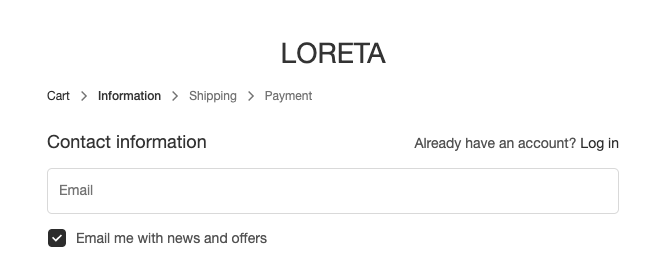
Progress indicators give shoppers a clear sense of how far they’ve come and what remains, reducing Shopify checkout abandonment caused by fatigue, frustration, or uncertainty.

Even with all your best strategies, some shoppers may still abandon checkout.
In these cases, giving customers the option to add items to a wishlist directly from the checkout page can help recapture their interest later.
A wishlist feature keeps potential buyers engaged with your Shopify store, increasing the likelihood they’ll return to complete the purchase.
It also gives you a valuable dataset for retargeting and remarketing campaigns, allowing you to send personalized reminders, promotions, or product updates based on what customers have expressed interest in.
Shopify store owners, apps like Wishlist Plus, Growave, or Gift Reggie make it easy to integrate wishlists seamlessly into the checkout process.
Highlighting a simple “Save for Later” or “Add to Wishlist” button near the cart summary or checkout steps ensures the feature is visible without interrupting the purchase flow.
Though they’re often used synonymously, there’s a clear difference between abandoned cart and abandoned checkout.
Cart abandonment occurs when a potential customer has added items to their cart but does not proceed towards the checkout page at all.
They make their way out either after glancing at the mini cart, or else after seeing the full cart page.
Checkout abandonment occurs when a potential customer has already clicked on “checkout” and has landed on the checkout page.
However, for a variety of reasons, they can exit this stage either while filling out their payment or shipping details.
Shopify specifically looks at two separate elements to calculate cart abandonment rate:
The rate is then calculated by:
(Number of visitors who added items to cart - Number of successful sales) / Number of visitors who added items to cart
While the ideal checkout abandonment rate would be 0%, realistically, that’s just not possible.
So if you have a Shopify business and you don’t have an abandonment rate that exceeds 40%, that’s considered good.
However, businesses that are doing exceedingly well have an abandonment rate of about 20%.
According to Shopify, anything above 3.3% is considered to be an excellent conversion rate amongst businesses on the platform.
Only about 20% of all Shopify businesses clock such numbers.
To ensure customers experience an easy checkout flow, you’ll have to ensure:
Checkout optimization is a set of carefully applied strategies that can help customers experience a smoother checkout process while reducing friction & distraction and increasing trust & confidence.
The journey towards checkout is initiated as soon as the customer has added a product to their cart.
The very next step to a final cart page is checkout, which can either be a one-page process or lasting several pages.
98% of visitors who visit an eCommerce site drop off without buying anything.
Even when you feature the best ecommerce promotions.
Why: user experience issues that cause friction for visitors.
And this is the problem Convertcart solves.
We've helped 500+ eCommerce stores (in the US) improve user experience and 2X their conversions.
How we can help you:
Our conversion experts can audit your site - identify UX issues, and suggest changes to improve conversions.